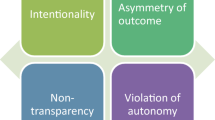Abstract
This paper explores the problem of knowledge in computational informational organisms, i.e. organisms that include a computing machinery at the artifact side. Although information can be understood in many ways, from the second half of the past century information is getting more and more digitised, von Neumann machines becoming dominant. Computational information is a challenge for the act of measuring, as neither purely quantitative nor totally qualitative approaches satisfy the need to explain the interplay among the agents producing and managing computational information. In this paper, Floridi’s method of levels of abstraction is applied to the analysis of computational information, with a chief interest in the concepts of information measure, quantification and quality.



Similar content being viewed by others
Notes
The term is used in this paper in the generic sense, not in its logical meaning, as it does not refer to quantifiers.
Here and elsewhere, we use the common expression “the LoA of some object”: this is a short way to express the right concept of “the LoA associated to some object as in the mind of the describer/writer/observer/agent” where the context identifies the human being involved.
Mathematically, this structure is the one of integers modulo 2n, represented in the binary notation. The usual integers do not possess the structure of vectors of Booleans, and the reals are not even representable, as discussed in Sect. 4.3.
An interesting remark posed by an anonymous reviewer is whether a LoA is needed for the VNM to compute. Here, is evident that a LoA is strictly needed: the computation really performed by a VNM has no meaning unless understood as the result of the encoding of the abstract LoA into the “real machine”. For example, the operation x + 32 at the VNM level increments the number x by 32, while, in a LoA which codes characters using the ASCII table, the same operation converts upper case letters into lower-case (this example comes from the standard library of the C language, so it refers to real code)—and it is “correct” only when x is an upper-case letter, otherwise one has to accept, e.g., that the lower-case form of 1 is Q, and that the lower-case form of z does not exist.
We are illustrating the most widely studied notion, the one of worst-case analysis: there are also studies about average performances, but they are outside the scope of this paper.
References
Beavers AF (2011) Historicizing floridi: the question of method, the state of the profession, and the timeliness of floridi’s philosophy of information. Etica Polit Ethics Polit XIII(2):225–275
Bridges DS, Vîţă LS (2011) Apartness and uniformity: a constructive development. Springer, Berlin
Brooks FP (1995) The mythical man-month: essays on software engineering, Anniversary Edition edn. Addison Wesley Longman, Boston
Burks AW, Goldstine HH, von Neumann J (1946) Preliminary discussion of the logical design of an electronic computing instrument, Institute for Advanced Study, Princeton, New Jersey
Costantini S, Gobbo F (2013) A history of autonomous agents: from thinking machines to machines for thinking. In: Local proceedings of the nature of computation. 9th conference on computability in Europe, CiE 2013. Milan, Italy
Floridi L (2008) The method of levels of abstraction. Minds Mach 18(3):303–329
Floridi L (2011) The philosophy of information. Oxford University Press, Oxford
Floridi L (2013) Information quality. Philos Technol 26:1–26
Floridi L (2013) Technology’s in-betweeness. Philos Technol 26:111–115
Fortnow L (2013) The golden ticket: P, NP, and the search for the impossible. Princeton University Press, Princeton
Floridi L (2013) The ethics of information. Oxford University Press, Oxford
Gobbo F, Benini M (2013) From ancient to modern computing: a history of information hiding. IEEE Ann Hist Comput 35(3):33–39. doi:10.1109/MAHC.2013.1
Gobbo F, Benini M (forthcoming) Why zombies can’t write significant source code. J Exp Theor Artif Intell
Hennessy JL, Patterson DA (2006) Computer architecture: a quantitative approach, 4th edn. Morgan Kaufmann Publishers, Burlington
Kay AC (1972) A personal computer for children of all ages. In: Proceedings of the ACM annual conference—vol 1, ACM ’72
Papadimitriou CH (1994) Computational complexity. Addison Wesley, Boston
Shoham Y (1990) Agent oriented programming. Technical Report STAN-CS-90-1335 Computer Science Department, Stanford University
The Onlife Group (2013) The onlife manifesto. Tech. rep, European Commission
Turner R (2013) Programming languages as technical artifacts. Philos Technol 1–21. doi:10.1007/s13347-012-0098-z
Upton E, Halfacree G (2013) Raspberry Pi user guide. Wiley, Hoboken
von Neumann J (1993) First draft of a report on the EDVAC. IEEE Ann Hist Comput. doi:10.1109/85.238389
Acknowledgments
We would like to thank all participants of the Fifth Workshop of the Philosophy of Information for their useful feedbacks to our work, and the reviewers for their compelling and interesting remarks. Also, Dr. Benini has been supported in this research by the project “Correctness by Construction” (CORCON), EU 7th framework programme, grant n. PIRSES-GA-2013-612638, and by the project “Abstract Mathematics for Actual Computation: Hilbert′s Program in the 21st Century” from the John Templeton Foundation. Dr. Gobbo holds the Special Chair in Interlinguistics and Esperanto at the University of Amsterdam (UvA), Faculty of Humanities, on behalf of the Universal Esperanto Association (UEA, Rotterdam). The content and opinions expressed in this article are the authors′ and they do not necessarily reflect the opinions of the institutions supporting them.
Author information
Authors and Affiliations
Corresponding author
Rights and permissions
About this article
Cite this article
Gobbo, F., Benini, M. What Can We Know of Computational Information? Measuring, Quantity, and Quality at Work in Programmable Artifacts. Topoi 35, 203–212 (2016). https://doi.org/10.1007/s11245-014-9248-5
Published:
Issue Date:
DOI: https://doi.org/10.1007/s11245-014-9248-5




